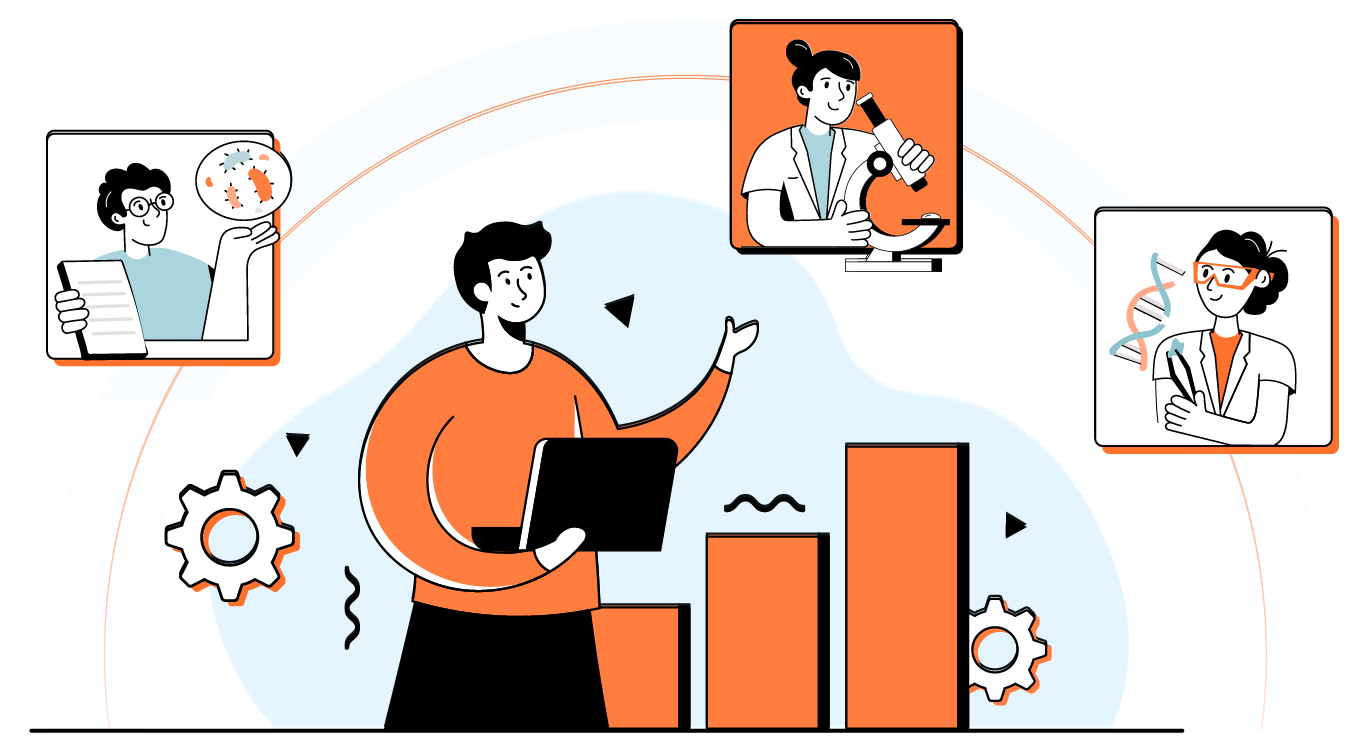THE SCIENCE OF SELLING TO SCIENTISTS
CHAPTER 1
Introduction:
Selling to Scientists
In this chapter, we introduce the fundamental principles of engaging with a scientifically literate audience, providing a foundation for the rest of the guide.

Contents
– Introduction
– The Unique Nature of the Scientific Audience
– Key Principles for Selling to Scientists
– Conclusion
Selling to scientists requires an intimate understanding of how they make decisions and build an affinity for products and services. Scientists have deep appreciation for data and evidence to prove your claims, however, the scientific community also looks to their peers and networks for reassurance and social proof that your product is adding value in other laboratories and workplaces.
The Unique Nature of the Scientific Audience
Scientists are a unique demographic. Their work revolves around meticulous research, critical analysis, and the pursuit of reproducible, verifiable results, and as a result, their decision making and purchasing behavior can be more pragmatic and evidence driven than a typical buyers. To successfully engage a scientific buyer, you must first understand their background, their objectives, and most importantly, the problems they are trying to solve.
Scientists are naturally curious, but they are often very sceptical as well. When you are selling to scientists, you have to have a lot of accurate data to present to them. The same marketing and sales techniques might not work as well if you can’t also provide graphs and hard data. Having referrals from their peers who they trust and can speak to directly will also be important.
Key Principles for Selling to Scientists
Become familiar with their klout and expertise
Most scientific researchers have built a wealth of experience in one, or several application areas – without understanding what their historical research looks like you are setting low expectations for the nature of your professional relationship – specifically, you’re losing an opportunity to contextualize why your product or service aligns with the work they are doing.
Research their publication history and speaking engagements to know what topics are most prevalent.
Understanding their network and collaborators
The scientific community is a small and closely knit – understanding who your prospect’s collaborators are, what products and services they use, and what overlapping interests they may have can aid you in both identifying new social proof
A member of their network may already be an advocate for your product or service – knowing this can make a difference when trying to open new doors.
Understanding their communities
Most scientists are affiliated with organizations and societies that are aligned to their research objectives. Learn about their affiliations – it may be a good source of new prospects in addition to or finding more about your prospect’s challenges.
Understanding key dates in the calendar
Scientists lead busy professional lives. They are hard at work, but also make time to present their findings on webinars and at scientific events. Go to these events to meet potential buyers in person and use past and upcoming events as a talking point to build an affinity with your prospect.
Data-Driven Communication
Scientists value empirical evidence. When presenting your product or service, emphasize data and provide examples. Use case studies, research findings, and detailed metrics to support your claims. If possible, include references to publications that cite your product or service in their research. This approach not only demonstrates credibility, but also aligns with their evidence-driven mindset.
Understanding the Scientific Method
Familiarize yourself with the scientific method and study design processes—the systematic approach scientists use to prepare research objectives and gather knowledge. This understanding helps you appreciate their decision-making process, enabling you to present your solutions in a way that resonates with their methodical approach to problem-solving.
Demonstrate Your Expertise
Establishing credibility is paramount. Scientists respect expertise and peer validation. Highlight your team’s qualifications, showcase testimonials from respected figures in the scientific community, and ensure your communications are precise and well-informed. If possible, cite publications and other references that may include your product or service – it provides both peer validation and social proof that you are adding value to other scientific projects.
Tailor Your Messaging
Generic sales pitches fall flat with this audience. Tailor your messaging to address the specific needs and challenges of their field. Demonstrate a deep understanding of their work and how your product or service can enhance their research outcomes or streamline their processes.
Align with Scientific Values
Scientists prioritize accuracy, reliability, and reproducibility. Your sales strategy should reflect these values. Ensure your product claims are accurate, up to date, and backed by data. Offer opportunities for trials or demonstrations to allow scientists to validate your claims through their own testing and experience.
Navigating the Sales Cycle
The sales cycle in the scientific market can be lengthy and involves multiple stakeholders. Be prepared for a rigorous evaluation process, including detailed discussions, product trials, and possibly peer reviews. It is important to qualify who the buying committee is as early as possible and understand how their purchasing is funded, approved, and how often funding becomes available.
Build Long-Term Relationships
Long-term relationships are more valuable than quick wins. Scientific buying is rarely transactional, and one purchase can often lead to repeated orders. Foster ongoing engagement by providing continuous support, regular updates, and educational content that helps scientists stay informed about advancements related to your offerings. This sustained interaction builds loyalty and positions you as a trusted partner in their research endeavors.
Example
Oonagh is attempting to contact the principal investigator at ABC Biotech, Inc. A contract research organization specializing in upstream bioprocessing and media optimization. While researching the investigator, Oonagh finds a recorded seminar they previously presented that mentions a competitor device. Quickly, Oonagh compares her product’s citations with the competitor device and sees her product is contributing to more publications, faster than the competitor.
Oonagh makes a note of the presentation title, the competitor device, and the high-level comparisons with two example references – all of this will be incredibly valuable to mention when speaking with the investigator.
Conclusion
Selling to scientists is not just about presenting a product—it’s about aligning with their values, understanding their processes, and providing evidence-based solutions that enhance their work. This chapter lays the groundwork for developing a sales strategy that resonates with the scientific community, setting the stage for the detailed insights and tactics covered in the subsequent chapters.
As you proceed through this guide, you’ll gain a deeper understanding of how to effectively research, reach, and engage scientists, ultimately driving successful sales outcomes in this unique and rewarding market.
The Science of Selling to Scientists
1: Introduction - Selling to Scientists
2: Researching the Researchers
3: Tools for Researching
4: Lists, Alerts & Signal Monitoring
5: Prospecting: Grants & Funding Research
6: Prospecting: Publications, Authors & Collaborators
7: Prospecting: Tradeshow Attendance & Participation
8: How to Write Cold Sales Prospecting Emails
9: Cold Sales Prospecting: LinkedIn
10: Automating Sales Prospecting
11: Conclusion
UP NEXT
Carry on Reading

CHAPTER 2
Researching the Researchers – How to understand your lead’s scientific background and research objectives.
There are many angles you can take when contacting a scientific buyer, and a lot of the information about their professional background and work is available to find online. This chapter discusses the different types of available data to better understand your scientific buyer, and how to use it.
FREE DOWNLOAD
Prefer a PDF Download?
Visit the link below and download all 10 chapters in one convenient guide.
“SciLeads has been critical to the success of our sales and marketing efforts. I don’t know where we would be without its data and insights.”
Commerical Marketing Director
your pipeline
with SciLeads


